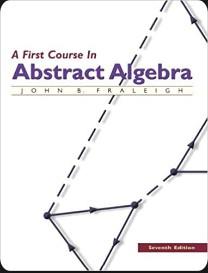In using the three isomorphism theorems, it is often necessary to know the actual correspondence given by
Question:
In using the three isomorphism theorems, it is often necessary to know the actual correspondence given by the isomorphism and not just the fact that the groups are isomorphic.
In the group Z24 , let H = (4) and N = (6).
a. List the elements in H N ( which we might write H + N for these additive groups) and in H ∩ N.
b. List the cosets in H N/N, showing the elements in each coset.
c. List the cosets in H/(H ∩ N), showing the elements in each coset.
d. Give the correspondence between H N/N and H/(H ∩ N) described in the proof of Theorem 34.5.
Data from Theorem 34.5.
Let H be a subgroup of G and let N be a normal subgroup of G. Then (HN)/N ≈ H/(H ∩ N).
Proof Let γ : G → G/N be the canonical homomorphism and let H ≤ G. Then γ[H] is a subgroup of G/N by Theorem 13.12. Now the action of γ on just the elements of H (called γ restricted to H) provides us with a homomorphism mapping H onto γ[H], and the kernel of this restriction is clearly the set of elements of N that are also in H, that is, the intersection H ∩ N. Theorem 34.2 then shows that there is an isomorphism µ1 : H/(H ∩ N) → γ[H].
On the other hand, γ restricted to HN also provides a homomorphism mapping HN onto γ[H], because γ(n) is the identity N of G/N for all n ∈ N. The kernel of γ restricted to HN is N. Theorem 34.2 then provides us with an isomorphism μ2: (HN)/N → γ[H].
Step by Step Answer:






